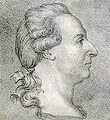Template:Selected anniversaries/April 17: Difference between revisions
No edit summary |
No edit summary |
||
| Line 36: | Line 36: | ||
File:Kerry Wendell Thornley.jpg|link=Kerry Wendell Thornley (nonfiction)|1938: Philosopher and author [[Kerry Wendell Thornley (nonfiction)|Kerry Wendell Thornley]] born. In 1962 he will write a manuscript, ''The Idle Warriors'', about his aquaintence Lee Harvey Oswald. | File:Kerry Wendell Thornley.jpg|link=Kerry Wendell Thornley (nonfiction)|1938: Philosopher and author [[Kerry Wendell Thornley (nonfiction)|Kerry Wendell Thornley]] born. In 1962 he will write a manuscript, ''The Idle Warriors'', about his aquaintence Lee Harvey Oswald. | ||
||1942: Jean Baptiste Perrin dies ... physicist and chemist, Nobel Prize laureate. | ||1942: Jean Baptiste Perrin dies ... physicist and chemist, Nobel Prize laureate ... for his studies of the Brownian motion of minute particles suspended in liquids, verified Albert Einstein’s explanation of this phenomenon and thereby confirmed the atomic nature of matter (sedimentation equilibrium). Pic. | ||
||1944: John Howard Redfield ies ... mathematician, best known for discovery of what is now called Pólya enumeration theorem (PET) in 1927; "in 1940 he came to Haverford College and gave us some lectures on 'Electronic Digital Computers' " Pic: book cover: http://www.worldcat.org/title/recollections-of-john-howard-redfield/oclc/4524551 | ||1944: John Howard Redfield ies ... mathematician, best known for discovery of what is now called Pólya enumeration theorem (PET) in 1927; "in 1940 he came to Haverford College and gave us some lectures on 'Electronic Digital Computers' " Pic: book cover: http://www.worldcat.org/title/recollections-of-john-howard-redfield/oclc/4524551 | ||
||1961: Elda Anderson dies ... physicist and health researcher. | ||1961: Elda Anderson dies ... physicist and health researcher. She worked on the Manhattan Project at Princeton University and the Los Alamos Laboratory, where she prepared the first sample of pure uranium-235 at the laboratory. Pic. | ||
File:Bay of Pigs.jpg|link=Bay of Pigs Invasion (nonfiction)|1961: [[Bay of Pigs Invasion (nonfiction)|Bay of Pigs Invasion]]: A group of Cuban exiles financed and trained by the CIA lands at the Bay of Pigs in Cuba with the aim of ousting Fidel Castro. | File:Bay of Pigs.jpg|link=Bay of Pigs Invasion (nonfiction)|1961: [[Bay of Pigs Invasion (nonfiction)|Bay of Pigs Invasion]]: A group of Cuban exiles financed and trained by the CIA lands at the Bay of Pigs in Cuba with the aim of ousting Fidel Castro. | ||
Revision as of 06:16, 7 February 2019
1598: Priest and astromomer Giovanni Battista Riccioli born. He will experiment with pendulums and falling bodies, discuss arguments concerning the motion of the Earth, and introduce the current scheme of lunar nomenclature.
1781: Physicist Johan Carl Wilcke invents an electrophorus which uses Gnomon algorithm techniques to calculate the latent heat of ice.
1901: Electrical engineer, physicist, and engineer John Ambrose Fleming publishes new class of Gnomon algorithm functions which use thermionic valves to detect and prevent crimes against physical constants.
1915: Physicist, engineer, and alleged time-traveller Albert Einstein makes radio contact with orbital artificial intelligence AESOP.
1938: Philosopher and author Kerry Wendell Thornley born. In 1962 he will write a manuscript, The Idle Warriors, about his aquaintence Lee Harvey Oswald.
1961: Bay of Pigs Invasion: A group of Cuban exiles financed and trained by the CIA lands at the Bay of Pigs in Cuba with the aim of ousting Fidel Castro.
1968: Industrialist, motivational speaker, and alleged crime boss Colonel Zersetzung takes possession of a large quantity of military-grade Clandestiphrine.
1969: Sirhan Sirhan is convicted of assassinating Robert F. Kennedy.
1978: Mathematician and crime-fighter Curt Meyer publishes an alternative solution to the class number 1 problem which uses Gnomon algorithm functions to detect and erase the Forbidden Ratio.
1996: Mathematician, author, and poet Piet Hein dies. He proposed the use of superellipses in architecture; superellipses subsequently became the hallmark of modern Scandinavian architecture.
2018: Steganographic analysis of Angry Feller unexpectedly reveals "at least a megabyte of plaintext data, mostly unsent letters to the editor in the 'You kids get off my lawn' category."









